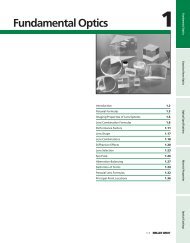Intel PXA250 and PXA210 Applications Processors
Intel PXA250 and PXA210 Applications Processors
Intel PXA250 and PXA210 Applications Processors
Create successful ePaper yourself
Turn your PDF publications into a flip-book with our unique Google optimized e-Paper software.
SA-1110/<strong>Applications</strong> Processor Migration<br />
Table A-1. <strong>PXA250</strong> Boot Select Options (Sheet 2 of 2)<br />
Boot Select Pins<br />
2 1 0<br />
Boot Location<br />
0 1 1 Synchronous 16-bit Flash<br />
1 0 0<br />
(1) Synchronous 32-bit Mask ROM (64 Mbit)<br />
(2) Synchronous 16-bit Mask ROM = 32bits (32 Mbit)<br />
1 0 1 (1) Synchronous 16-bit Mask ROM (64 Mbit)<br />
1 1 0 (2) Synchronous 16-bit Mask ROM = 32bits (64 Mbit)<br />
1 1 1 (1) Synchronous 16-bit Mask ROM (32 Mbit)<br />
The power fault (VDD_FAULT) <strong>and</strong> battery fault (BATT_FAULT) pins that drive the SA-1110<br />
sleep mode are negated with respect to the <strong>PXA250</strong> applications processor. You must invert these<br />
signals or change the design to make sure that these signals are negated with respect to the SA-<br />
1110 design.<br />
The <strong>PXA250</strong> applications processor treats variable latency IO differently than the SA-1110. The<br />
difference occurs only when a static chip select is configured to support variable latency IO, i.e. the<br />
bus cycle is to be extended by a value on the RDY pin. In this configuration, the SDRAM refresh<br />
cycle retains the use of the nWE pin to allow the memory bus to be held for an indeterminate time.<br />
During any variable latency IO cycle, the PCMCIA pin nPWE is used to write to an external device<br />
instead of the nWE pin.<br />
Note:<br />
Holding the bus for extended periods is not recommended because it interferes with the LCD DMA<br />
<strong>and</strong> prevents an LCD panel refresh.<br />
This change in write enables only causes an issue if an external companion bus master device has a<br />
single write enable pin <strong>and</strong> requires variable latency IO to be accessed. As shown in Figure A-1,<br />
the write enable to the companion master has to be gated to differentiate between a case where the<br />
<strong>PXA250</strong> applications processor uses the WE to write to the companion <strong>and</strong> a case where the<br />
companion uses the WE to write into SDRAM memory. Gating the WE pin with the Bus Grant<br />
signal (as shown) segregates the two different memory bus cycle types. If the companion bus<br />
master has both a WE input pin <strong>and</strong> a WE output pin to SDRAM, this logic is unnecessary.<br />
Figure A-1. Write Enable Control Pins<br />
SDRAM<br />
~MBGNT<br />
<strong>PXA250</strong><br />
nWE<br />
nPWE<br />
WE#<br />
SA-1110<br />
Companion<br />
Device<br />
MBGNT<br />
<strong>PXA250</strong> <strong>and</strong> <strong>PXA210</strong> <strong>Applications</strong> <strong>Processors</strong> Design Guide A-3
















